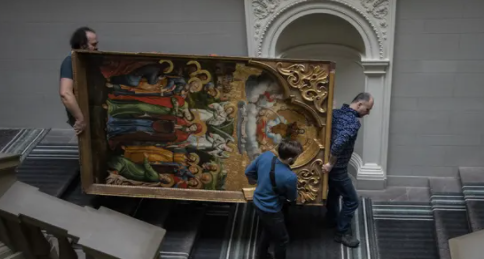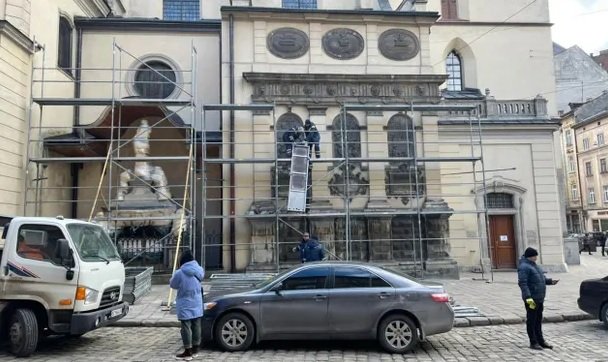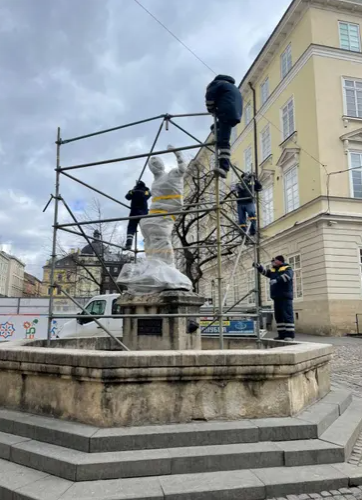Ukrainians in race to save cultural heritage

Originally written by Luke Harding in Lviv and Harriet Sherwood. Published by The Guardian, 9 March 2022.
Standing in front of Lviv’s Latin cathedral, Lilya Onyshchenko offered her view of the invading Russians. “They are barbarians. They don’t care what they destroy,” she said. “I haven’t met Hitler. I think Putin is worse. He’s a devil, not a human,” she added, standing in the historic centre of one of Europe’s most culturally important cities.
Behind her, construction workers were busy erecting scaffolding around a Renaissance chapel. The friezes showing Jesus – in the garden of Gethsemane, being arrested by Roman soldiers – were about to be wrapped up. Around the corner a team perched on a giant crane were boarding up the cathedral’s stain-glass windows.

“If we lose our culture we lose our identity,” said Onyschenko, the head of Lviv’s city council heritage protection office. “Lviv has always been multicultural. Poles, Germans, Jews, Armenians and Hungarians built it. It’s Unesco listed.” She said she and her colleagues were working their way through a long list of objects that needed to be protected.
Russia’s war on Ukraine has been an all-round disaster. Its army has shelled densely populated cities, killing hundreds. More than 2 million refugees have fled abroad in Europe’s biggest exodus since the second world war. In besieged Mariupol, families have spent more than a week living in desperate conditions without heat, water or power.
Alongside this humanitarian catastrophe, cultural assets have been bombed and damaged. They include a museum in the city of Ivankiv, north-west of Kyiv, which housed dozens of works by the Ukrainian folk artist Maria Prymachenko, some now lost forever. Last week Russian forces shelled the assumption cathedral in Kharkiv, hurling debris into its nave.
In a video recorded early on Tuesday Ukraine’s president, Volodymyr Zelenskiy, said Moscow had flattened a 19th-century wooden church in the village of Viazivka, in the western Zhytomyr region. “An act of genocide against the Ukrainian nation,” Olha Rutkovska, a member of the association for the protection of monuments, posted on Facebook.
Many Ukrainians believe this vandalism is no accident. In an essay last summer Putin claimed Ukraine and Russia were “one people” and Zelenskiy has argued the Kremlin’s ultimate goal is the “erasure” of Ukraine as an independent sovereign state. That includes its language, people and culture, suppressed during previous eras of Russification.
“The USSR was one big totalitarian regime,” Lviv museum director Olha Honchar told the Guardian. “They tried to make everything the same. They had one kind of monument, and one kind of artistic style with socialist realism. Moscow wants to eradicate Ukrainian culture. It’s what defines us and our identity. It’s a memory of who we are.”
Honchar – who runs the city’s memorial museum of totalitarian regimes – said Ukrainian artists had resisted domination by Moscow, during communist times and today. Singers, actors and musicians had joined Ukraine’s self-defence forces and were fighting against Russia. The film star Pasha Lee was killed on Sunday in shelling in Irpin, outside Kyiv.
A group of museum directors had launched an initiative to send funds to cultural workers across the country. They included museum and library staff living in southern cities such as Kherson, now under Russian occupation. None had been paid, with the stipends from the European Commission and other donors used to buy food, Honchar said.
“Russians are used to living in a totalitarian system. They’ve been zombified. We Ukrainians value critical thinking,” she said. “The idea that Russia and Ukraine are the same is a totalitarian myth dreamed up in Moscow. Lenin didn’t invent us. We are different.” Her museum built on the site of Lviv’s Jewish ghetto is closed to visitors, with artefacts tucked away.
This week several of the city’s other treasures were hidden. They included a precious wooden alter-piece showing Jesus, Mary and Mary Magdalene. It was removed from Lviv’s 14th century Armenian church and transported to a bunker. The sculpture was last removed from its courtyard spot shortly before the Nazis swept into the city in 1941. Remarkably, Lviv’s historic architecture survived the second world war.
On Tuesday city council workers in blue boiler suits rescued four limestone fountains adorned with mythical sculptures. Each occupies a corner of Lviv’s old market square. Neptune and his trident vanished under fire resistant cladding. So did Amphitrite, Neptune’s wife, and Diana and Adonis – the work of neo-classical German sculptor Hartman Witwer.

In Kyiv, the situation is more perilous. In the weeks before the war the culture minister, Oleksandr Tkachenko, took few steps to preserve the capital’s heritage. The Zelenskiy government was reluctant to remove exhibits, fearing this would contribute to a mood of panic. Some works are now being withdrawn from galleries, including Kyiv’s art museum with its 19th century Russian masterpieces.
Maria Glazunova who works at Kyiv’s national film archive, said the city authorities had started showing some of its collection in metro stations, used by locals as shelter from Russian artillery. They were screening silent films and cartoons, including a popular animation starring the character Petryk Pyatochkin, put on in Dorohozhychi station.
Elsewhere in the country the picture is bleak. Concerns have been raised about the fate of a small museum devoted to Anton Chekhov in Sumy, in north-eastern Ukraine, where the Russian playwright spent time as a youth in the late 1880s. Fighting has been reported close to the museum. An airstrike killed several civilians on Tuesday, including children.
Lazare Eloundou, head of Unesco’s World Heritage Centre, said the UN’s cultural body was receiving “more and more reports of the destruction of cultural heritage in several cities”.
Of particular concern was Kharkiv, which is designated a Unesco creative city “with a vibrant cultural life” and Chernihiv, where the 11th century city centre had been damaged. “There are many others. The whole of cultural life has been affected, and we have grave concerns about what will happen next,” Eloundou said.
Unesco officials were in contact with cultural professionals in Ukraine, he added. “People are taking action to protect cultural heritage. We are providing what assistance we can. We are working with our international partners to monitor damage using satellite imagery. We will continue to bring together cultural heritage professionals to put together an action plan,” he said.
Elondou described Ukraine’s heritage as “important for the entire world”. It is the responsibility of the international community to do what it can to protect world heritage sites. As well as protecting cultural heritage for its own sake, it will also help the people of Ukraine to recover from the trauma after this conflict,” he said.
Volunteers are identifying and archiving material from Ukrainian cultural institutions to save it for future generations. More than 1,000 librarians, archivists and researchers are involved in Saving Ukrainian Cultural Heritage Online, using a combination of technologies to crawl and archive sites and content.
Back at the Latin cathedral, the sound of praying could be heard from several side-chapels – together with banging and the whirr of a drill from workers outside. The lavish rococo interior with its gilt and magenta colours is intact – for now. “The world won’t protect our air space. In the meantime we will protect our cultural monuments,” Onyshchenko said.